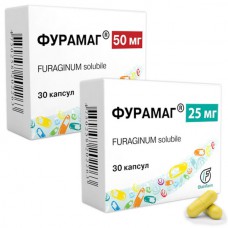Expiration date: 01/2027
Composition and form of release:
Capsules 1 capsule of
furazidine potassium salt 25 mg
excipients: magnesium hydroxycarbonate potassium carbonate talc
capsule composition No. 4: titanium dioxide (E171) iron oxide yellow dye (E172) gelatin
in a contour cell pack of 10 pcs. in a pack of cardboard 2, 3, 4, 5 packages.
Capsules 1 capsule of
furazidine potassium salt 50 mg
excipients: magnesium hydroxycarbonate potassium carbonate talc
capsule composition No. 3: titanium dioxide (E171) quinoline yellow dye (E104) gelatin
in a contour cell package of 10 pcs. in a pack of cardboard 2, 3, 4, 5 packages.
Description of the dosage form:
Capsules of 25 mg: solid gelatin capsules No. 4, brownish yellow.
Capsules of 50 mg: solid gelatin capsules No. 3, yellow.
Contents of capsules: powder from orange-brown to reddish-brown, the presence of white, yellow, orange and orange-brown particles is allowed.
Pharmacokinetics:
Absorption occurs in the small intestine, by passive diffusion. Absorption of nitrofurans from the distal segment of the small intestine exceeds absorption from the proximal and middle segments by 2 and 4 times, respectively (should be taken into account when simultaneously treating urogenital infections and gastrointestinal diseases, including chronic enteritis). Nitrofurans are poorly absorbed in the colon.
Furamag, being a mixture of potassium furazidine and magnesium hydroxycarbonate in a ratio of 1:1, when administered orally, has a higher bioavailability than furazidine (after taking Furamag capsules in the acidic environment of the stomach, there is no conversion of potassium furazidine into poorly soluble furazidine). The drug is distributed evenly in the body. Clinically important is the high content of the active substance in the lymph (delays the spread of infection through the lymphatic pathways). In bile, its concentration is several times higher than in blood serum, and in liquor - several times lower than in serum. In saliva, the content of furazidine is 30% of its concentration in blood serum. The concentration of furazidine in blood and tissues is relatively small, which is due to its rapid release, while the concentration in urine is much higher than in blood. Cmax in the blood persists from 3 to 7 or 8 hours, furazidine is detected in the urine 3-4 hours after application.
Unlike nitrofurantoin (furadonin), after taking Furamag, the pH of urine does not change. 4 hours after taking the drug, the concentration of furazidine in the urine significantly exceeds the concentration that is formed after taking the same dose of the drug Furagin. Excretion through the kidneys occurs during glomerular filtration and tubular secretion (85%), partially undergoes reverse reabsorption in the tubules. At low concentrations of the drug in the urine, the filtration and secretion process prevails, at high concentrations, secretion decreases and reabsorption increases. Furazidine, being a weak acid, does not dissociate in acidic urine, undergoes intensive reabsorption, which can increase the development of systemic side effects. When urine is alkalinized, the excretion of furazidine increases.
Slightly biotransformed (less than 10%). With a decrease in the excretory function of the kidneys, the intensity of metabolism increases.
Description of pharmacological action:
A broad-spectrum antimicrobial agent belonging to the group of nitrofurans.
Resistance to Furamag develops slowly and does not reach a high degree.
It is active against gram-positive and gram-negative microbes, pathogenic strains of Staphylococcus spp. and other microorganisms resistant to antibiotics.
It is effective against gram-positive cocci (strepto-, staphylococci), gram-negative rods (Escherichia coli, salmonella, shigella, proteus, Klebsiella, Enterobacteria), protozoa (giardia). In relation to Staphylococcus spp., E.coli, Aerobacter aerogenes, Bact. citrovorum, Proteus mirabilis, Proteus morganii Furamag, compared with other nitrofurans, is more active. Furamag shows higher activity to Enterococcus faecalis, Staphylococcus spp. no compared to other antimicrobial groups.
Against most bacteria, the bacteriostatic concentration ranges from 1:100,000 to 1:200,000, the bactericidal concentration is about 2 times more. Under the influence of nitrofurans in microorganisms, the respiratory chain and the tricarboxylic acid cycle (Krebs cycle) are suppressed, as well as other biochemical processes in microorganisms are inhibited, resulting in the destruction of their shell or cytoplasmic membrane. As a result of the action of nitrofurans, microorganisms emit fewer toxins, and therefore an improvement in the general condition of the patient is possible even before the pronounced suppression of the growth of microflora. Nitrofurans, unlike many other antimicrobial agents, not only do not inhibit the body's immune system, but on the contrary, activate it (increase the complement titer and the ability of leukocytes to phagocyte microorganisms). Nitrofurans in therapeutic doses stimulate leukopoiesis.
Indications:
- Infections caused by microorganisms sensitive to furazidine.
- urogenital infections (acute cystitis, urethritis, pyelonephritis)
- skin and soft tissue infections
- severe infected burns
- gynecological infections
- It can be used prophylactically during urological operations, cystoscopy, catheterization, etc.
Contraindications:
- hypersensitivity to drugs of the nitrofuran group
- pregnancy
- breast-feeding
- severe chronic renal failure
- children under 3 years of age (for this dosage form).
With caution: renal insufficiency, glucose-6-phosphate dehydrogenase deficiency.
Side effect:
Furamag is low-toxic. Side effects characteristic of other nitrofurans were rarely observed: headache, dizziness, nausea, vomiting, loss of appetite, polyneuritis, liver dysfunction, allergic reactions (skin rash, papular rashes).
If, during the treatment with Furamag, side effects are found that are not specified in this description, then it is necessary to inform the attending physician.
Drug interaction:
Furamag should not be used simultaneously with ristomycin, chloramphenicol, sulfonamides (the risk of inhibition of hematopoiesis increases).
During the treatment period, it is advisable to refrain from drinking alcoholic beverages, because side effects may increase.
It is not recommended to prescribe drugs capable of "acidifying" urine (including ascorbic acid, calcium chloride) simultaneously with nitrofurans.
Method of administration and dosage:
Inside, after eating, with plenty of liquid.
Adults - 50-100 mg (2-4 caps. 25 mg or 1-2 caps. 50 mg) 3 times a day.
Children - 25-50 mg (1-2 caps. 25 mg) 3 times a day, but no more than 5 mg / kg / day.
The course of treatment is 7-10 days, if necessary, the course is repeated after 10-15 days.
For the prevention of infection during urological operations, cystoscopy, catheterization, etc. - adults 50 mg for children - 25 mg once 30 minutes before the procedure.
If the next dose is not taken, the next one should be taken at the usual time. You can not take a double dose to replace the missed one.
Overdose:
Symptoms: in case of overdose, neurotoxic symptoms, ataxia and tremor are observed.
Treatment: in case of poisoning, a large amount of liquid should be drunk. Antihistamines are used to relieve acute symptoms. For the prevention of neuritis, it is possible to prescribe vitamins (thiamine bromide).
Special instructions:
To reduce the likelihood of side effects, Furamag is washed down with a large amount of liquid. If side effects occur, the use of the drug is discontinued (toxic phenomena are more often manifested in patients with reduced excretory function of the kidneys).
Influence on the ability to drive a car or perform work that requires increased speed of physical and mental reactions. Not marked.




